Multidimensional Visualization and Processing of Big Open Urban Geospatial Data on the Web
Abstract
:1. Introduction
2. An Overview of Technologies
2.1. Open Standards
- Subsetting (downloading a subset of a coverage by trimming or slicing);
- Range subsetting (extracting a band or bands of a coverage);
- Condensing (consolidating cell values of a coverage along selected axes to a scalar value based on a condensing operation, such as calculating minimum, maximum, average or sum of the cell values);
- Constructing a coverage (creating a new coverage on the fly and filling it with values resulting from a processing expression evaluation);
- Applying induced operations (using a unary or binary function, that may include arithmetic, comparison, Boolean, trigonometric and logarithmic operations and case distinction that works on a single cell and applying it to all the cells of a coverage simultaneously).
A datacube is a massive multidimensional array, also called ’raster data’ or ’gridded data’; ’massive’ entails [...] sizes significantly beyond the main memory resources of the server hardware—otherwise, processing can be done satisfactorily with existing array tools like MATLAB or R.
2.2. Free and Open Source Software
3. Results
3.1. Multidimensional Vector Geospatial Data Visualization
3.1.1. OSM Data Visualization
3.1.2. CityGML Data Visualization
3.2. Multidimensional Raster Geospatial Data Visualization, Query and Processing
3.2.1. Ground Deformation Visualization and Query
3.2.2. LULC Visualization, Query and Processing
3.2.3. Mobility Visualization
4. Conclusions
Author Contributions
Funding
Conflicts of Interest
References
- MacEachren, A.M.; Kraak, M.J. Research Challenges in Geovisualization. Cartogr. Geogr. Inf. Sci. 2001, 28, 3–12. [Google Scholar] [CrossRef]
- Virrantaus, K.; Fairbairn, D.; Kraak, M.J. ICA Research Agenda on Cartography and GIScience. Cartogr. Geogr. Inf. Sci. 2009, 36, 209–222. [Google Scholar] [CrossRef] [Green Version]
- Çöltekin, A.; Bleisch, S.; Andrienko, G.; Dykes, J. Persistent challenges in geovisualization—A community perspective. Int. J. Cartogr. 2017, 3, 115–139. [Google Scholar] [CrossRef] [Green Version]
- Gore, A. The Digital Earth: Understanding our planet in the 21st Century. Aust. Surv. 1998, 43, 89–91. [Google Scholar] [CrossRef]
- Craglia, M.; Goodchild, M.F.; Annoni, A.; Camara, G.; Gould, M.; Kuhn, W.; Mark, D.; Masser, I.; Maguire, D.; Liang, S.; et al. Next-Generation Digital Earth: A position paper from the Vespucci Initiative for the Advancement of Geographic Information Science. Int. J. Spat. Data Infrastruct. Res. 2008, 3, 146–167. [Google Scholar]
- Grossner, K.E.; Goodchild, M.F.; Clarke, K.C. Defining a Digital Earth System. Trans. GIS 2008, 12, 145–160. [Google Scholar] [CrossRef]
- Craglia, M.; de Bie, K.; Jackson, D.; Pesaresi, M.; Remetey-Fülöpp, G.; Wang, C.; Annoni, A.; Bian, L.; Campbell, F.; Ehlers, M.; et al. Digital Earth 2020: Towards the vision for the next decade. Int. J. Digit. Earth 2012, 5, 4–21. [Google Scholar] [CrossRef]
- Goodchild, M.F.; Guo, H.; Annoni, A.; Bian, L.; de Bie, K.; Campbell, F.; Craglia, M.; Ehlers, M.; van Genderen, J.; Jackson, D.; et al. Next-generation Digital Earth. Proc. Natl. Acad. Sci. USA 2012, 109, 11088–11094. [Google Scholar] [CrossRef] [Green Version]
- Veenendaal, B.; Brovelli, M.A.; Li, S. Review of Web Mapping: Eras, Trends and Directions. ISPRS Int. J. Geo-Inf. 2017, 6, 317. [Google Scholar] [CrossRef]
- Hibbard, B. Top Ten Visualization Problems. ACM SIGGRAPH Comput. Graph. 1999, 33, 21–22. [Google Scholar] [CrossRef]
- Johnson, C. Top Scientific Visualization Research Problems. IEEE Comput. Graph. Appl. 2004, 24, 13–17. [Google Scholar] [CrossRef] [PubMed]
- Laramee, R.S.; Kosara, R. Challenges and Unsolved Problems. In Human-Centered Visualization Environments; Kerren, A., Ebert, A., Meyer, J., Eds.; Springer: Heidelberg, Germany, 2007; pp. 231–254. [Google Scholar]
- Guo, D. Visual analytics of spatial interaction patterns for pandemic decision support. Int. J. Geogr. Inf. Sci. 2007, 21, 859–877. [Google Scholar] [CrossRef]
- Bertolotto, M.; Di Martino, S.; Ferrucci, F.; Kechadi, T. Towards a framework for mining and analysing spatio-temporal datasets. Int. J. Geogr. Inf. Sci. 2007, 21, 895–906. [Google Scholar] [CrossRef]
- Sips, M.; Schneidewind, J.; Keim, D.A. Highlighting space–time patterns: Effective visual encodings for interactive decision-making. Int. J. Geogr. Inf. Sci. 2007, 21, 879–893. [Google Scholar] [CrossRef]
- Li, S.; Dragicevic, S.; Castro, F.A.; Sester, M.; Winter, S.; Coltekin, A.; Pettit, C.; Jiang, B.; Haworth, J.; Stein, A.; et al. Geospatial big data handling theory and methods: A review and research challenges. ISPRS J. Photogramm. Remote Sens. 2016, 115, 119–133. [Google Scholar] [CrossRef] [Green Version]
- Ferraz, V.R.T.; Santos, M.T.P. GlobeOLAP: Improving the Geospatial Realism in Multidimensional Analysis Environment. In Proceedings of the 12th International Conference on Enterprise Information Systems, Funchal, Portugal, 8–12 June 2010; Filipe, J., Cordeiro, J., Eds.; SciTePress: Setúbal, Portugal, 2010. [Google Scholar]
- Blower, J.D.; Gemmell, A.L.; Griffiths, G.H.; Haines, K.; Santokhee, A.; Yang, X. A Web Map Service implementation for the visualization of multidimensional gridded environmental data. Environ. Model. Softw. 2013, 47, 218–224. [Google Scholar] [CrossRef] [Green Version]
- Li, W.; Wang, S. PolarGlobe: A web-wide virtual globe system for visualizing multidimensional, time-varying, big climate data. Int. J. Geogr. Inf. Sci. 2017, 31, 1562–1582. [Google Scholar] [CrossRef]
- Cappelaere, P.; Sánchez, S.; Bernabé, S.; Scuri, A.; Mandl, D.; Plaza, A. Cloud Implementation of a Full Hyperspectral Unmixing Chain within the NASA Web Coverage Processing Service for EO-1. IEEE J. Sel. Top. Appl. Earth Obs. Remote Sens. 2013, 6, 408–418. [Google Scholar] [CrossRef]
- Karmas, A.; Tzotsos, A.; Karantzalos, K. Scalable Geospatial Web Services through Efficient, Online and Near Real-time Processing of Earth Observation Data. In Proceedings of the 2015 IEEE First International Conference on Big Data Computing Service and Applications, San Francisco, CA, USA, 30 March–3 April 2015; pp. 194–201. [Google Scholar]
- Karmas, A.; Karantzalos, K. Benchmarking Server-Side Software Modules for Handling and Processing Remote Sensing Data Through Rasdaman. In Proceedings of the 2015 7th Workshop on Hyperspectral Image and Signal Processing: Evolution in Remote Sensing (WHISPERS), Tokyo, Japan, 2–5 June 2015; pp. 1–4. [Google Scholar]
- Baumann, P.; Mazzetti, P.; Ungar, J.; Barbera, R.; Barboni, D.; Beccati, A.; Bigagli, L.; Boldrini, E.; Bruno, R.; Calanducci, A.; et al. Big Data Analytics for Earth Sciences: The EarthServer approach. Int. J. Digit. Earth 2016, 9, 3–29. [Google Scholar] [CrossRef]
- Tzotsos, A.; Karmas, A.; Merticariu, V.; Misev, D.; Baumann, P.A. Datacube Approach to Agro-Geoinformatics. In Proceedings of the 2017 6th International Conference on Agro-Geoinformatics, Fairfax, VA, USA, 7–10 August 2017; pp. 1–6. [Google Scholar]
- Baumann, P.; Kohler, K.; Merticariu, V.; Isroilov, I. Using Datacube Technology for In-Situ-Enhanced Precision Farming. In Proceedings of the 7th ACM SIGSPATIAL International Workshop on Analytics for Big Geospatial Data (BigSpatial 2018), Seattle, WA, USA, 6 November 2018; pp. 10–15. [Google Scholar]
- Bernard, L.; Kanellopoulos, I.; Annoni, A.; Smits, P. The European geoportal—One step towards the establishment of a European Spatial Data Infrastructure. Comput. Environ. Urban Syst. 2005, 29, 15–31. [Google Scholar] [CrossRef]
- Bartha, G.; Kocsis, S. Standardization of Geographic Data: The European INSPIRE Directive. Eur. J. Geogr. 2011, 2, 79–89. [Google Scholar]
- Esch, T.; Asamer, H.; Bachofer, F.; Balhar, J.; Boettcher, M.; Boissier, E.; d’Angelo, P.; Gevaert, C.M.; Hirner, A.; Jupova, K.; et al. Digital world meets urban planet–new prospects for evidence-based urban studies arising from joint exploitation of big earth data, information technology and shared knowledge. Int. J. Digit. Earth 2020, 13, 136–157. [Google Scholar] [CrossRef]
- Pepe, A.; Bonano, M.; Bordogna, G.; Brovelli, M.; Calo, F.; Carrara, P.; Congedo, L.; Frigerio, L.; Imperatore, P.; Lanari, R.; et al. The “URBAN GEOmatics for Bulk Information Generation, Data Assessment and Technology Awareness” Project: Detection, Representation and Analysis of the Urban Scenario Changes. In Proceedings of the 2018 IEEE International Geoscience and Remote Sensing Symposium, Valencia, Spain, 22–27 July 2018; pp. 2902–2905. [Google Scholar]
- Brovelli, M.A.; Boccardo, P.; Bordogna, G.; Pepe, A.; Crespi, M.; Munafò, M.; Pirotti, F. Urban Geo Big Data. In The International Archives of the Photogrammetry, Remote Sensing and Spatial Information Sciences, Proceedings of the FOSS4G 2019—Academic Track, Bucharest, Romania, 26–30 August 2019; Brovelli, M.A., Marin, A.F., Eds.; Copernicus Publications: Göttingen, Germany, 2019; pp. 23–30. [Google Scholar]
- Oxoli, D.; Sabri, S.; Rajabifard, A.; Brovelli, M.A. A classification technique for local multivariate clusters and outliers of spatial association. Trans. GIS 2020, 1–21. [Google Scholar] [CrossRef]
- Doraiswamy, H.; Freire, J.; Lage, M.; Miranda, F.; Silva, C. Spatio-Temporal Urban Data Analysis: A Visual Analytics Perspective. IEEE Comput. Graph. Appl. 2018, 38, 26–35. [Google Scholar] [CrossRef] [PubMed]
- Baumann, P.; Misev, D.; Merticariu, V.; Huu, B.P. Datacubes: Towards Space/Time Analysis-Ready Data. In Service-Oriented Mapping; Döllner, J., Jobst, M., Schmitz, P., Eds.; Springer: Cham, Switzerland, 2019; pp. 269–299. [Google Scholar]
- Baumann, P. Management of Multidimensional Discrete Data. VLDB J. 1994, 3, 401–444. [Google Scholar] [CrossRef] [Green Version]
- Baumann, P.; Dehmel, A.; Furtado, P.; Ritsch, R.; Widmann, N. The Multidimensional Database System RasDaMan. In Proceedings of the ACM SIGMOD International Conference on Management of Data, Seattle, WA, USA, 2–4 June 1998; Tiwary, A., Franklin, M., Eds.; ACM Press: New York, NY, USA, 1998; pp. 575–577. [Google Scholar]
- Baumann, P.; Dehmel, A.; Furtado, P.; Ritsch, R.; Widmann, N. Spatio-Temporal Retrieval with RasDaMan. In Proceedings of the 25th International Conference on Very Large Data Bases, Edinburgh, Scotland, UK, 7–10 September 1999; Atkinson, M.P., Orlowska, M.E., Valduriez, P., Zdonik, S.B., Brodie, M.L., Eds.; Morgan Kaufmann Publishers: San Francisco, CA, USA, 1999; pp. 746–749. [Google Scholar]
- Furtado, P.; Baumann, P. Storage of Multidimensional Arrays Based on Arbitrary Tiling. In Proceedings of the 15th International Conference on Data Engineering, Sydney, Australia, 23–26 March 1999; Kitsuregawa, M., Maciaszek, L., Papazoglou, M., Pu, C., Eds.; IEEE Computer Society: Washington, DC, USA, 1999; pp. 480–489. [Google Scholar]
- Baumann, P.; Dumitru, A.M.; Merticariu, V. The Array Database That Is Not a Database: File Based Array Query Answering in Rasdaman. In Advances in Spatial and Temporal Databases; Nascimento, M.A., Sellis, T., Cheng, R., Sander, J., Zheng, Y., Kriegel, H.P., Renz, M., Sengstock, C., Eds.; Springer: Heidelberg, Germany, 2013; pp. 478–483. [Google Scholar]
- Baumann, P.; Merticariu, V. On the Efficient Evaluation of Array Joins. In Proceedings of the 2015 IEEE International Conference on Big Data (Big Data), Santa Clara, CA, USA, 29 October–1 November 2015; Ho, H., Chin Ooi, B., Zaki, M.J., Hu, X., Haas, L., Kumar, V., Rachuri, S., Yu, S., Hui-I Hsiao, M., Li, J., et al., Eds.; IEEE: Piscataway, NJ, USA, 2015; pp. 2046–2055. [Google Scholar]
- Dumitru, A.M.; Merticariu, V.; Baumann, P. Array Database Scalability: Intercontinental Queries on Petabyte Datasets. In Proceedings of the 28th International Conference on Scientific and Statistical Database Management, Budapest, Hungary, 18–20 July 2016; Baumann, P., Manolescu-Goujot, I., Trani, L., Ioannidis, Y., Barnaföldi, G.G., Dobos, L., Bányai, E., Eds.; ACM Press: New York, NY, USA, 2016; pp. 1–5. [Google Scholar]
- Dumitru, A.; Merticariu, V.; Baumann, P. Exploring Cloud Opportunities from an Array Database Perspective. In Proceedings of the ACM SIGMOD/PODS Conference, Snowbird, UT, USA, 22–27 June 2014; Katsifodimos, A., Tzoumas, K., Babu, S., Eds.; ACM Press: New York, NY, USA, 2014; pp. 1–4. [Google Scholar]
- Goodchild, M.F. Citizens as sensors: The world of volunteered geography. GeoJournal 2007, 69, 211–221. [Google Scholar] [CrossRef] [Green Version]
- See, L.; Estima, J.; Podör, A.; Arsanjani, J.J.; Bayas, J.C.L.; Vatseva, R. Sources of VGI for Mapping. In Mapping and the Citizen Sensor; Foody, G., See, L., Fritz, S., Mooney, P., Olteanu-Raimond, A., Fonte, C., Antoniou, V., Eds.; Ubiquity Press: London, UK, 2017; pp. 13–35. [Google Scholar]
- Mooney, P.; Minghini, M. A Review of OpenStreetMap Data. In Mapping and the Citizen Sensor; Foody, G., See, L., Fritz, S., Mooney, P., Olteanu-Raimond, A., Fonte, C., Antoniou, V., Eds.; Ubiquity Press: London, UK, 2017; pp. 37–59. [Google Scholar]
- Goetz, M.; Zipf, A. The Evolution of Geo-Crowdsourcing: Bringing Volunteered Geographic Information to the Third Dimension. In Crowdsourcing Geographic Knowledge; Sui, D., Elwood, S., Goodchild, M., Eds.; Springer: Dordrecht, The Netherlands, 2013; pp. 139–159. [Google Scholar]
- Sarjakoski, T. Networked GIS for Public Participation—Emphasis on Utilizing Image Data. Comput. Environ. Urban Syst. 1998, 22, 381–392. [Google Scholar] [CrossRef]
- Yang, P.P.J.; Putra, S.Y.; Li, W. Viewsphere: A GIS-based 3D visibility analysis for urban design evaluation. Environ. Plan. B Plan. Des. 2007, 34, 971–992. [Google Scholar] [CrossRef] [Green Version]
- Lee, J. A Three-Dimensional Navigable Data Model to Support Emergency Response in Microspatial Built-Environments. Ann. Assoc. Am. Geogr. 2007, 97, 512–529. [Google Scholar] [CrossRef]
- Lee, J.; Zlatanova, S. A 3D data model and topological analyses for emergency response in urban areas. In Geospatial Information Technology for Emergency Response; Zlatanova, S., Lee, J., Eds.; Taylor & Francis Group: London, UK, 2008; pp. 159–184. [Google Scholar]
- Kolbe, T.H.; Gröger, G.; Plümer, L. CityGML–3D city models and their potential for emergency response. In Geospatial Information Technology for Emergency Response; Zlatanova, S., Lee, J., Eds.; Taylor & Francis Group: London, UK, 2008; pp. 257–274. [Google Scholar]
- Lee, J. 3D Data Model for Representing Topological Relations of Urban Features. In Proceedings of the 21st Annual Esri International User Conference, San Diego, CA, USA, 9–13 July 2001. [Google Scholar]
- Miranda, F.; Doraiswamy, H.; Lage, M.; Wilson, L.; Hsieh, M.; Silva, C.T. Shadow Accrual Maps: Efficient Accumulation of City-Scale Shadows Over Time. IEEE Trans. Vis. Comput. Graph. 2019, 25, 1559–1574. [Google Scholar] [CrossRef] [Green Version]
- Over, M.; Schilling, A.; Neubauer, S.; Zipf, A. Generating web-based 3D City Models from OpenStreetMap: The current situation in Germany. Comput. Environ. Urban Syst. 2010, 34, 496–507. [Google Scholar] [CrossRef]
- Goetz, M. Towards generating highly detailed 3D CityGML models from OpenStreetMap. Int. J. Geogr. Inf. Sci. 2013, 27, 845–865. [Google Scholar] [CrossRef]
- Goetz, M.; Zipf, A. Extending OpenStreetMap to Indoor Environments: Bringing Volunteered Geographic Information to the Next Level. In Urban and Regional Data Management; Zlatanova, S., Ledoux, H., Fendel, E.M., Rumor, M., Eds.; Taylor & Francis Group: London, UK, 2011; pp. 47–58. [Google Scholar]
- Wang, Z.; Zipf, A. Using OpenStreetMap Data to Generate Building Models with Their Inner Structures for 3D Maps. In ISPRS Annals of Photogrammetry, Remote Sensing & Spatial Information Sciences, Proceedings of the ISPRS Geospatial Week, Wuhan, China, 18–22 September 2017; Li, D., Gong, J., Yang, B., Wu, H., Lindenbergh, R., Boehm, J., Rutzinger, M., Yao, W., Weinmann, M., Zhang, Y., et al., Eds.; Copernicus Publications: Göttingen, Germany, 2017; pp. 411–416. [Google Scholar]
- Brovelli, M.A.; Zamboni, G. A New Method for the Assessment of Spatial Accuracy and Completeness of OpenStreetMap Building Footprints. ISPRS Int. J. Geo-Inf. 2018, 7, 289. [Google Scholar] [CrossRef] [Green Version]
- Fissore, F.; Pirotti, F. Migration of Digital Cartography to CityGML; a Web-Based Tool for Supporting Simple ETL Procedures. In International Archives of the Photogrammetry, Remote Sensing and Spatial Information Sciences, Proceedings of the ISPRS TC IV Mid-term Symposium “3D Spatial Information Science—The Engine of Change”, Delft, The Netherlands, 1–5 October 2018; Zlatanova, S., Dragicevic, S., Sithole, G., Eds.; Copernicus Publications: Göttingen, Germany, 2018; pp. 193–200. [Google Scholar]
- Gröger, G.; Plümer, L. CityGML—Interoperable semantic 3D city models. ISPRS J. Photogramm. Remote Sens. 2012, 71, 12–33. [Google Scholar] [CrossRef]
- Biljecki, F.; Stoter, J.; Ledoux, H.; Zlatanova, S.; Çöltekin, A. Applications of 3D City Models: State of the Art Review. ISPRS Int. J. Geo-Inf. 2015, 4, 2842–2889. [Google Scholar] [CrossRef] [Green Version]
- Schulte, C.; Coors, V. Development of a CityGML ADE for Dynamic 3D Flood Information. In Proceedings of the Joint ISCRAM-CHINA and GI4DM Conference on Information Systems for Crisis Management, Heilongjiang, China, 4–6 August 2008. [Google Scholar]
- Varduhn, V.; Mundani, R.P.; Rank, E. Multi-Resolution Models: Recent Progress in Coupling 3D Geometry to Environmental Numerical Simulation. In 3D Geoinformation Science; Breunig, M., Al-Doori, M., Butwilowski, E., Kuper, P.V., Benner, J., Haefele, K.H., Eds.; Springer: Cham, Switzerland, 2015; pp. 55–69. [Google Scholar]
- Amirebrahimi, S.; Rajabifard, A.; Mendis, P.; Ngo, T. A BIM-GIS integration method in support of the assessment and 3D visualisation of flood damage to a building. J. Spat. Sci. 2016, 61, 317–350. [Google Scholar] [CrossRef]
- Amirebrahimi, S.; Rajabifard, A.; Mendis, P.; Ngo, T. A framework for a microscale flood damage assessment and visualization for a building using BIM–GIS integration. Int. J. Digit. Earth 2016, 9, 363–386. [Google Scholar] [CrossRef]
- Tymkow, P.; Karpina, M.; Borkowski, A. 3D GIS for Flood Modelling in River Valleys. In International Archives of the Photogrammetry, Remote Sensing and Spatial Information Sciences, Proceedings of the XXIII ISPRS Congress, Prague, Czech Republic, 12–19 July 2016; Halounova, L., Šafář, V., Raju, P.L.N., Plánka, L., Ždímal, V., Srinivasa Kumar, T., Faruque, F.S., Kerr, Y., Ramasamy, S.M., Comiso, J., et al., Eds.; Copernicus Publications: Göttingen, Germany, 2016; pp. 175–178. [Google Scholar]
- Kilsedar, C.E.; Fissore, F.; Pirotti, F.; Brovelli, M.A. Extraction and Visualization of 3D Building Models in Urban Areas for Flood Simulation. In The International Archives of the Photogrammetry, Remote Sensing and Spatial Information Sciences, Proceedings of the GEORES 2019—2nd International Conference of Geomatics and Restoration, Milan, Italy, 8–10 May 2019; Brumana, R., Pracchi, V., Rinaudo, F., Grimoldi, A., Scaioni, M., Previtali, M., Cantini, L., Eds.; Copernicus Publications: Göttingen, Germany, 2019; pp. 669–673. [Google Scholar]
- Massonnet, D.; Feigl, K.L. Radar Interferometry and Its Application to Changes in the Earth’s Surface. Rev. Geophys. 1998, 36, 441–500. [Google Scholar] [CrossRef] [Green Version]
- Lanari, R.; Casu, F.; Manzo, M.; Zeni, G.; Berardino, P.; Manunta, M.; Pepe, A. An Overview of the Small BAseline Subset Algorithm: A DInSAR Technique for Surface Deformation Analysis. In Deformation and Gravity Change: Indicators of Isostasy, Tectonics, Volcanism, and Climate Change; Wolf, D., Fernández, J., Eds.; Springer: Basel, Switzerland, 2007; pp. 637–661. [Google Scholar]
- Lanucara, S.; Oggioni, A.; Modica, G.; Carrara, P. Interoperable Sharing and Visualization of Geological Data and Instruments: A Proof of Concept. In Computational Science and Its Applications—ICCSA 2017; Gervasi, O., Murgante, B., Misra, S., Borruso, G., Torre, C.M., Rocha, A.M.A.C., Taniar, D., Apduhan, B.O., Stankova, E., Cuzzocrea, A., Eds.; Springer: Cham, Switzerland, 2017; pp. 584–599. [Google Scholar]
- Kilsedar, C.E.; Frigerio, L.; Bonano, M.; Bordogna, G.; Carrara, P.; Imperatore, P.; Lanari, R.; Manzo, M.; Pepe, A.; Brovelli, M.A. Visualization of Big Geodata: An Experiment with DInSAR Deformation Time Series. In The International Archives of the Photogrammetry, Remote Sensing and Spatial Information Sciences, Proceedings of the FOSS4G 2019—Academic Track, Bucharest, Romania, 26–30 August 2019; Brovelli, M.A., Marin, A.F., Eds.; Copernicus Publications: Göttingen, Germany, 2019; pp. 135–141. [Google Scholar]
- Brewer, C.A. Color Use Guidelines for Mapping and Visualization. In Visualization in Modern Cartography; MacEachren, A.M., Taylor, D.R.F., Eds.; Elsevier: Oxford, UK, 1994; pp. 123–147. [Google Scholar]
- Harrower, M.; Brewer, C.A. ColorBrewer.org: An Online Tool for Selecting Colour Schemes for Maps. Cartogr. J. 2003, 40, 27–37. [Google Scholar] [CrossRef]
- Casu, F.; Manzo, M.; Lanari, R. A quantitative assessment of the SBAS algorithm performance for surface deformation retrieval from DInSAR data. Remote Sens. Environ. 2006, 102, 195–210. [Google Scholar] [CrossRef]
- Oxoli, D.; Molinari, M.E.; Brovelli, M.A. Hotspot Analysis, an open source GIS tool for exploratory spatial data analysis: Application to the study of soil consumption in Italy. Rend. Online Della Soc. Geol. Ital. 2018, 46, 82–87. [Google Scholar] [CrossRef]
- Oxoli, D.; Ronchetti, G.; Minghini, M.; Molinari, M.E.; Lotfian, M.; Sona, G.; Brovelli, M.A. Measuring Urban Land Cover Influence on Air Temperature through Multiple Geo-Data—The Case of Milan, Italy. ISPRS Int. J. Geo-Inf. 2018, 7, 421. [Google Scholar] [CrossRef] [Green Version]
- Deparday, V. Enhancing Volunteered Geographical Information (VGI) Visualization with Open Source Web-Based Software. Master’s Thesis, University of Waterloo, Waterloo, ON, Canada, 2011. [Google Scholar]
- Antonovic, M.; Brovelli, M.A.; Cannata, M.; Cardoso, M.; Kilsedar, C.E.; Minghini, M.; Zamboni, G. Promoting slow tourism through FOSS4G Web Mapping: An Italian-Swiss case study. In Geomatics Workbooks, Proceedings of the FOSS4G Europe 2015, Como, Italy, 14–17 July 2015; Brovelli, M.A., Minghini, M., Negretti, M., Eds.; Politecnico di Milano: Como, Italy, 2015; pp. 99–104. [Google Scholar]
- Brovelli, M.A.; Kilsedar, C.E.; Zamboni, G. Visualization of VGI Data Through the New NASA Web World Wind Virtual Globe. In The International Archives of the Photogrammetry, Remote Sensing and Spatial Information Sciences, Proceedings of the XXIII ISPRS Congress, Prague, Czech Republic, 12–19 July 2016; Halounova, L., Šafář, V., Raju, P.L.N., Plánka, L., Ždímal, V., Srinivasa Kumar, T., Faruque, F.S., Kerr, Y., Ramasamy, S.M., Comiso, J., et al., Eds.; Copernicus Publications: Göttingen, Germany, 2016; pp. 205–209. [Google Scholar]
- Kilsedar, C.E.; Bratic, G.; Molinari, M.E.; Minghini, M.; Brovelli, M.A. Open Educational Resources for Validation of Global High-Resolution Land Cover Maps. In PeerJ Preprints, Proceedings of the Open Source Geospatial Research & Education Symposium, Lugano, Switzerland, 9–11 October 2018; PeerJ: San Diego, CA, USA; London, UK, 2019; pp. 1–6. [Google Scholar]
- Brovelli, M.A.; Wu, H.; Minghini, M.; Molinari, M.E.; Kilsedar, C.E.; Zheng, X.; Shu, P.; Chen, J. Open Source Software and Open Educational Material on Land Cover Maps Intercomparison and Validation. In The International Archives of the Photogrammetry, Remote Sensing and Spatial Information Sciences, Proceedings of the ISPRS TC IV Mid-term Symposium “3D Spatial Information Science—The Engine of Change”, Delft, The Netherlands, 1–5 October 2018; Zlatanova, S., Dragicevic, S., Sithole, G., Eds.; Copernicus Publications: Göttingen, Germany, 2018; pp. 61–68. [Google Scholar]
- Oxoli, D.; Bratic, G.; Wu, H.; Brovelli, M.A. Extending Accuracy Assessment Procedures of Global Coverage Land Cover Maps Through Spatial Association Analysis. In The International Archives of the Photogrammetry, Remote Sensing and Spatial Information Sciences, Proceedings of the ISPRS Geospatial Week 2019, Enschede, The Netherlands, 10–14 June 2019; Vosselman, G., Oude Elberink, S.J., Yang, M.Y., Eds.; Copernicus Publications: Göttingen, Germany, 2019; pp. 1601–1607. [Google Scholar]

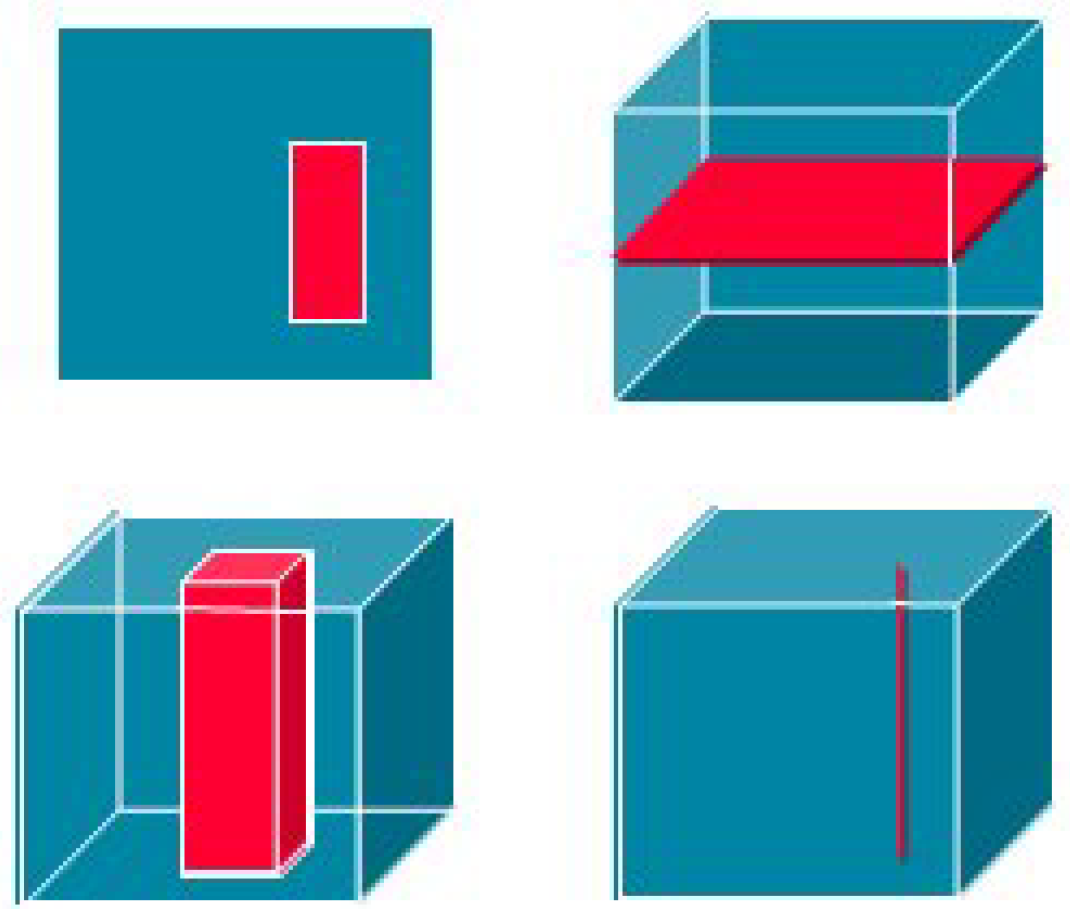
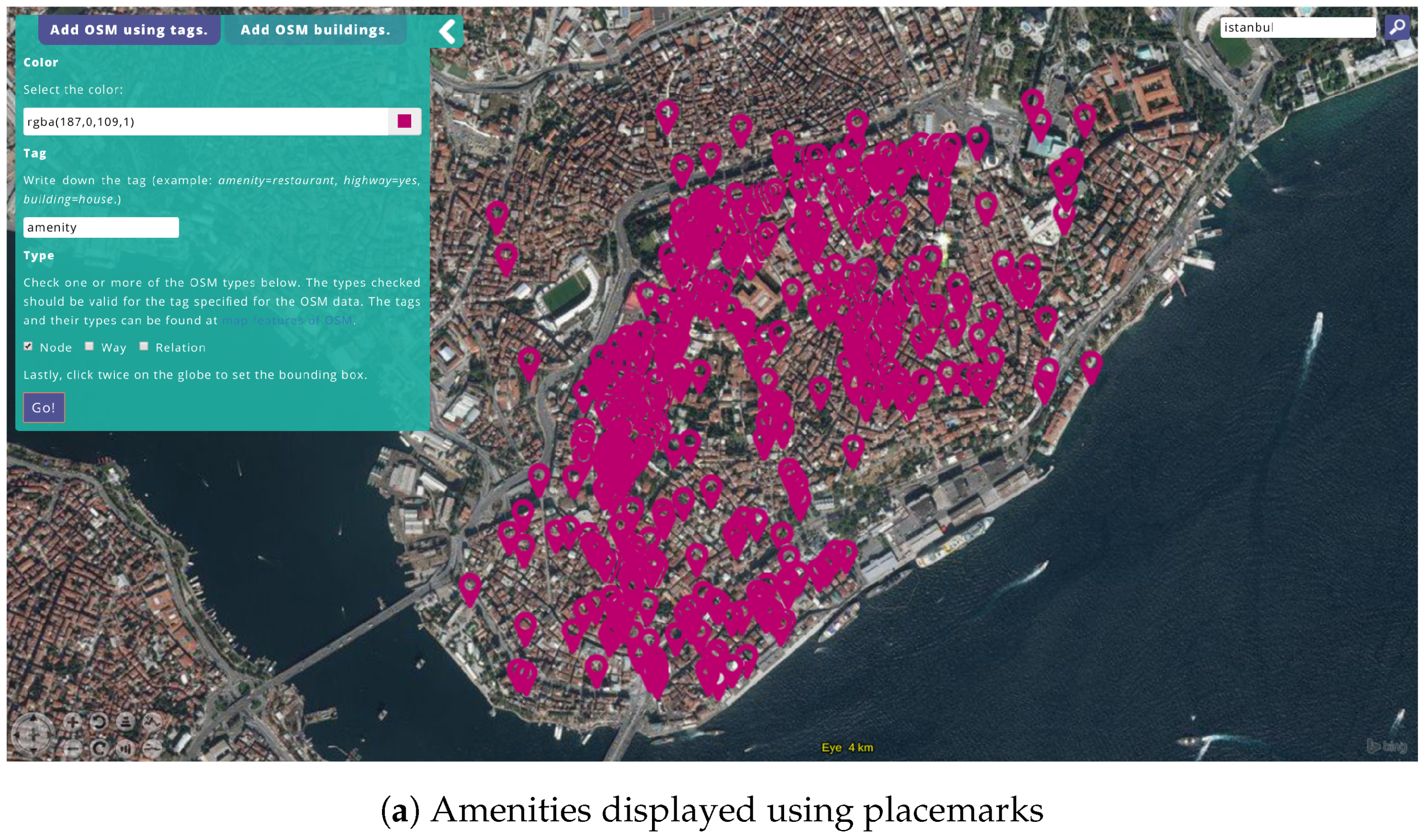


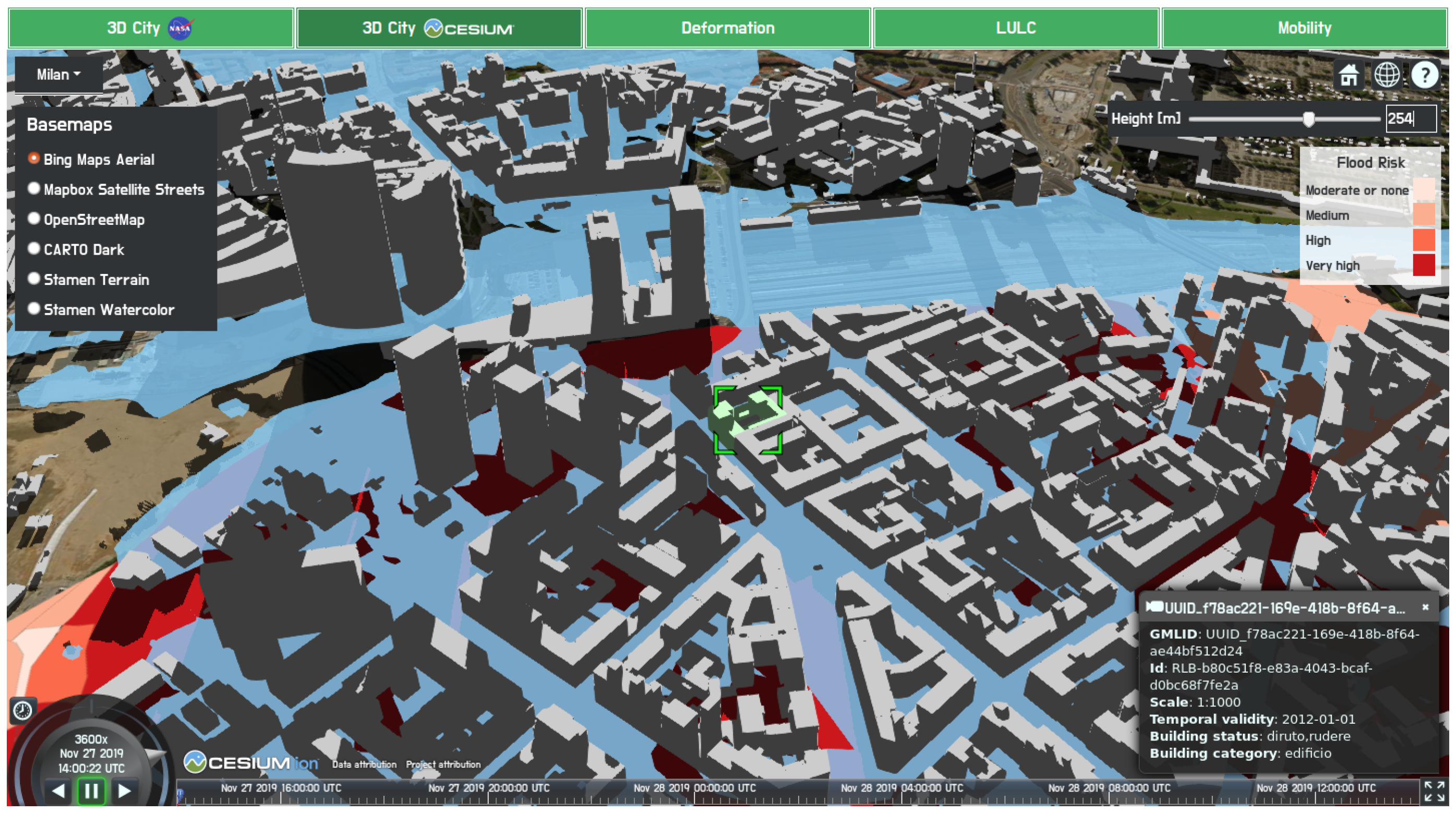



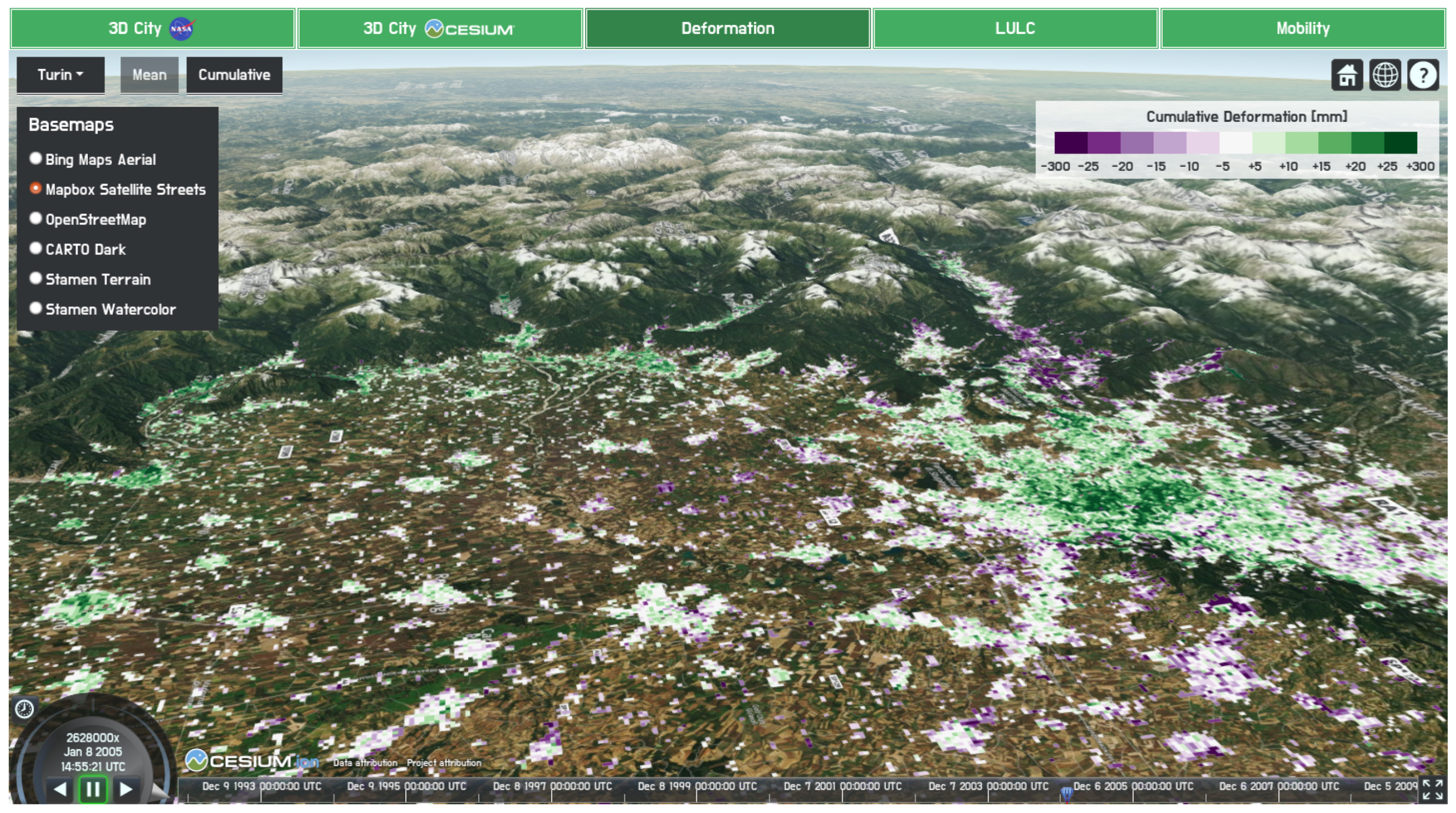




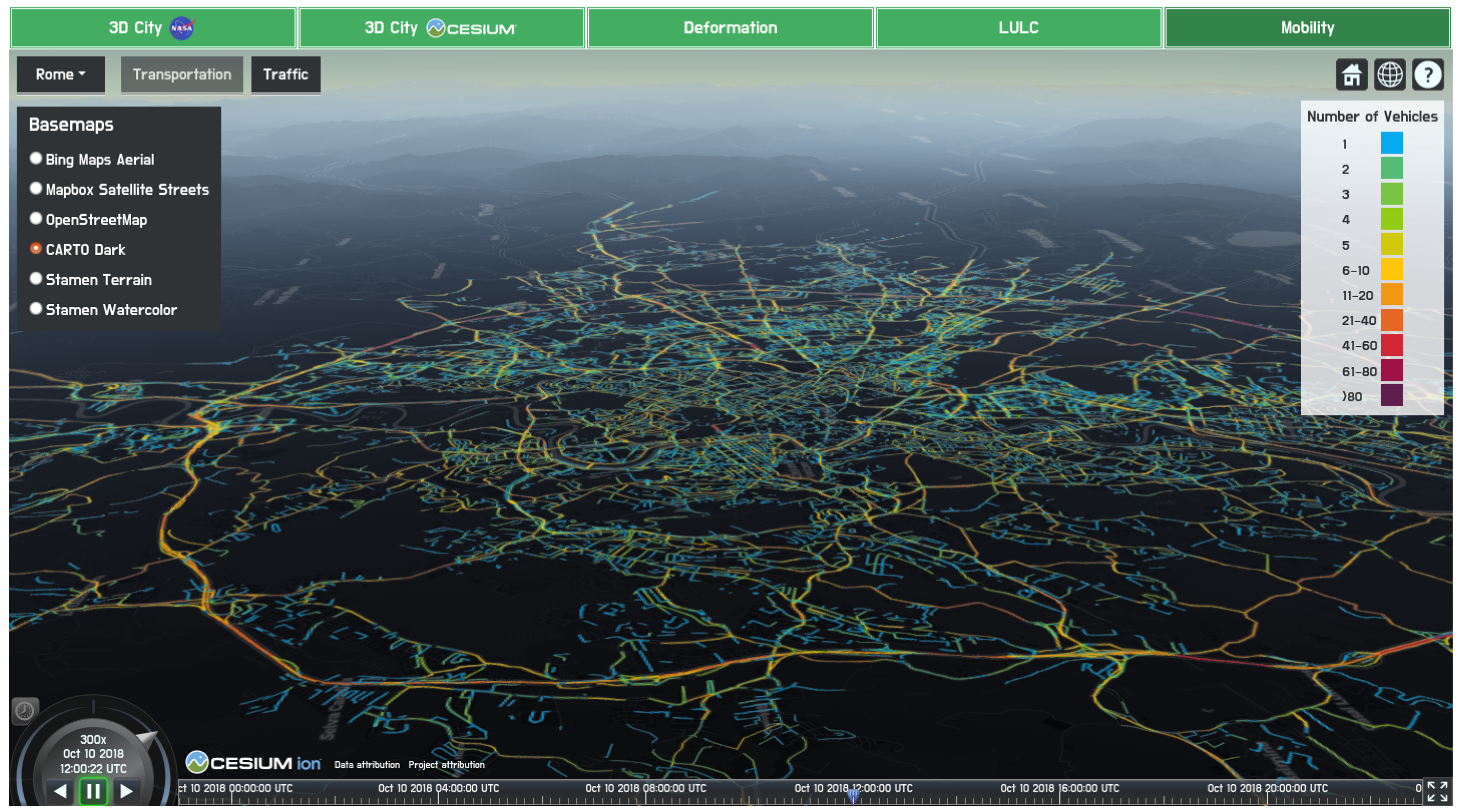
© 2020 by the authors. Licensee MDPI, Basel, Switzerland. This article is an open access article distributed under the terms and conditions of the Creative Commons Attribution (CC BY) license (http://creativecommons.org/licenses/by/4.0/).
Share and Cite
Kilsedar, C.E.; Brovelli, M.A. Multidimensional Visualization and Processing of Big Open Urban Geospatial Data on the Web. ISPRS Int. J. Geo-Inf. 2020, 9, 434. https://0-doi-org.brum.beds.ac.uk/10.3390/ijgi9070434
Kilsedar CE, Brovelli MA. Multidimensional Visualization and Processing of Big Open Urban Geospatial Data on the Web. ISPRS International Journal of Geo-Information. 2020; 9(7):434. https://0-doi-org.brum.beds.ac.uk/10.3390/ijgi9070434
Chicago/Turabian StyleKilsedar, Candan Eylül, and Maria Antonia Brovelli. 2020. "Multidimensional Visualization and Processing of Big Open Urban Geospatial Data on the Web" ISPRS International Journal of Geo-Information 9, no. 7: 434. https://0-doi-org.brum.beds.ac.uk/10.3390/ijgi9070434




